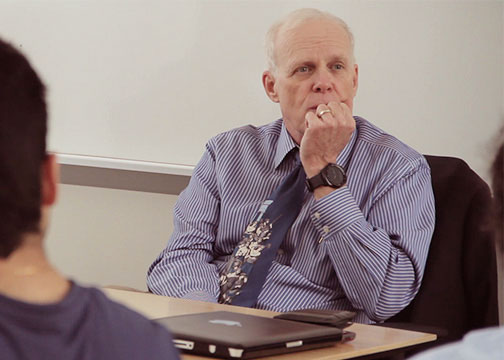For the second year in a row, Stanford Engineering Ph.D. students in the Accel Innovation Scholars (AIS) program welcomed a special guest who once filled their shoes. University President John Hennessy, who holds a Ph.D. in computer science, taught for many years and served as dean of the School of Engineering, came to the cohort’s class in late February to share his experience and wisdom.

The 12 doctoral candidates accepted into the AIS program learn the skills and possibilities of technology commercialization, opportunity evaluation and entrepreneurial leadership. And as someone who succeeded as an entrepreneur in industry, as well as a scientist and scholar, Stanford’s 10th president embodied the many possibilities for the participants in the AIS program.
“I wish I had had a program like this during my Ph.D.!” exclaimed Hennessy, who earned his doctorate from State University of New York at Stony Brook. “Doing a Ph.D. teaches you to be a problem-solver and how to work in a field that is not established.”
Making the leap from a Ph.D. to a startup, Hennessy said he “had to learn things the hard way, by making mistakes and learning from them.” In 1984, Hennessy co-founded MIPS Computer Systems, now MIPS Technologies, and then Atheros in 1998. He sits on the boards of Atheros Communications, Cisco Systems, Google and the Daniel Pearl Foundation.
When one AIS scholar asked Hennessy what was “the most innovative, disruptive thing” that he has done as president of Stanford, he said that he has concentrated most of his attention on trying to build a focus on interdisciplinary work to facilitate collaboration around large problems that wouldn’t be solved by one group of scholars — “to make the whole greater than the sum of the parts.”
He also shared his vision for Stanford: “We try to play from our own songbook. You can’t be in Silicon Valley and fail to be influenced by it — and most of that influence is for the good. Our goal is to increase our impact on the world through education and research. We are a relatively small institution and try to look for first-mover advantage in various fields. We don’t try to do everything. Our goal is to be in the top five in all our programs.”
Asked how he makes hard decisions, Hennessy first distinguished how university decisions differ from those of startups and then explained his decision-making process in his present role.
“Universities are semi-permanent structures here for the long term,” Hennessy said. “We have to project the impact of any big decision 100 years into the future.”
He added that university leaders have to think about everything — entitlements, impact on future generations and other dynamics. “We try to make sure that everyone with a stake in the decision has the opportunity to give an opinion,” he explained. “We then weigh the opinions and the impact of the decision on the various constituencies and into the future.”
Lastly, scholars asked about Stanford’s place in Silicon Valley. “Technology comes in waves of innovation,” Hennessy said. “A new insight, a new application creates an entire industry and many new companies. That’s what happened with the World Wide Web and social media. Innovation is cyclical. The key is to keep the innovation cycle going.”

